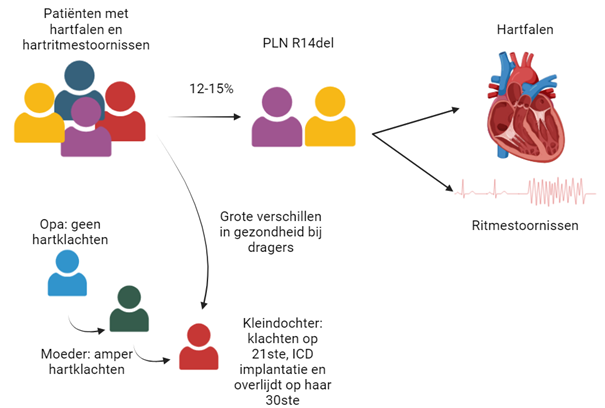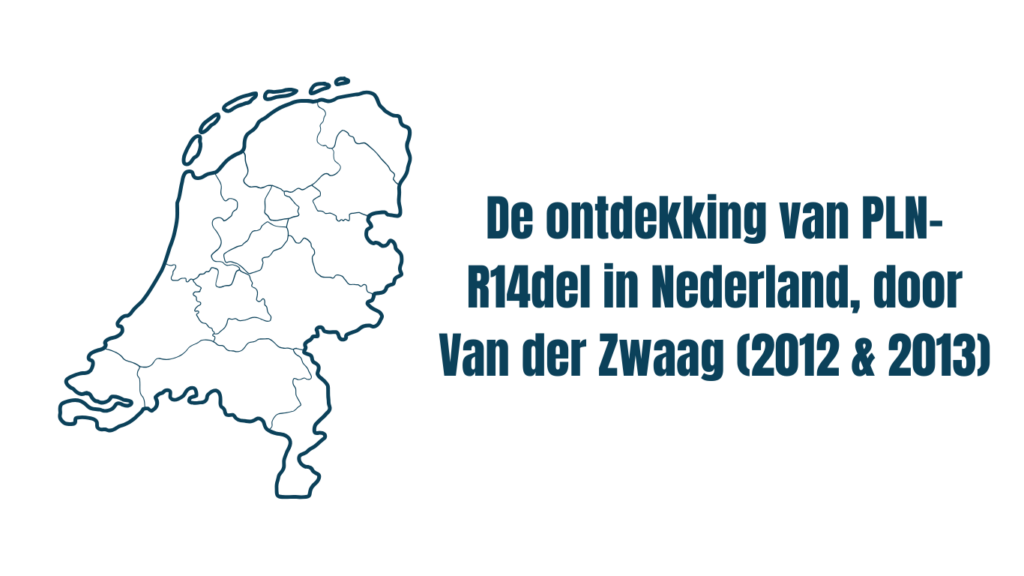Original article: Zwaag Van der, 2012, Eur.
Original article: Zwaag Van der, 2013, Neth.
In a previous article, we described the discovery of PLN-R14del in Greek cardiac patients. In 2009, an article appeared describing a German family where the mutation was identified. Following this news, Groningen doctors investigated whether the mutation might also occur in their patients.
To investigate whether R14del is also present in the Netherlands, the DNA of a large group of heart patients with heart failure or arrhythmias was examined. These patients were under treatment in Utrecht, Amsterdam and Groningen. Of the 354 patients examined, 49 were found to have the mutation. This means that 15% of patients with heart failure and 12% of patients with arrhythmias have this mutation. For a single mutation, this is very high.
Usually a mutation occurs in a few families with at most a few dozen carriers in total. But now 49 PLN carriers from different families were found immediately. In a follow-up study less than a year later, 101 different families were already known with a total of 459 carriers of this mutation.
Different manifestations and complaints
These carriers have very different manifestations of the disease. For example, a family of 3 generations of carriers is described. Grandfather never had any heart problems and dies at the age of 75. His daughter is found to have some skipping during examination, but is not otherwise bothered by anything. The granddaughter, on the other hand, at age 21, seeks help because she feels her heart skipping. Over the course of 9 years, she receives an ICD that goes off several times and develops heart failure. At 30, she dies while on the waiting list for a heart transplant. For these families, the PLN Foundation wants to be there and find a solution!
In a later article, we will discuss the different manifestations of PLN as heart disease.
POPULATION STUDY
If a mutation is so prevalent, it is interesting to see how often the mutation has been found in population studies. An older Groningen study included genetic information from more than 8,000 people. Of these, 6 people were found to have the mutation. That sounds very few, but if you calculate this over a population of 1.7 million in Groningen, Friesland and Drenthe, it would mean that there are 1250 carriers in those provinces alone. You understand that this was an extraordinary discovery for cardiologists.
ORIGIN OF THE MUTATION
We then looked at where and when this mutation arose. It was estimated that the mutation originated about 650-750 years ago. To trace where the mutation originated, the zip codes of patients and of their grandparents were compared. The highest number of zip codes was in eastern Friesland. Based on genealogical research and church books, in which all data on mourning, fidelity and baptism as well as marriage used to be written down, this could be traced back to three villages in eastern Friesland.
The main conclusion of this first article on R14del in the Netherlands? That one, although somewhat theoretical, is important. Heart diseases are divided into dilatation (dilation) of the heart and arrhythmias, among others. It was known that these diseases overlap, but this article describes a mutation that causes both. Thus, one cause, the mutation, can cause both diseases. Although this is only a theoretical classification of diseases, it is important for treatment. After all, patients are often treated by different doctors and receive different treatments. Thus, these two articles are not only very important for the discovery of R14del in the Netherlands, but also add new knowledge to the knowledge about heart disease in general.

Deepening:
How do we know that all the carriers are related?
If a change in DNA is so common in such a small area, the question is: how come so many carriers live together? Could it be that these people are related? You can investigate this by looking at certain markers in the DNA. A little background for this: in each cell there are two copies of a chromosome. One comes from the father and one from the mother. Now suppose this information were literally passed on to children this way, a man and a woman could have children with four genetic backgrounds (two options from two parents gives two times two is four). Genetically, then, only four different children, which is very few.
To increase variation, information can be exchanged between the two chromosomes during sex cell development. When this happens, reorganization of markers on the DNA also takes place. In families, this will make the creators very similar (because the markers are only reorganized a few times) while the markers are very different if people are not related.
Back to PLN: when the researchers looked at the markers on the DNA, they found that they are identical around the altered PLN gene in all PLN carriers. This proves that all people carrying PLN are related and have an ancestor. These markers were also checked in the DNA of carriers from America and Germany. As it turned out, these people share the markers and are thus descended from the same family. Back to the question: why do so many carriers live together? It is because the mutation arose once and was passed on by the ancestor to a large offspring.
